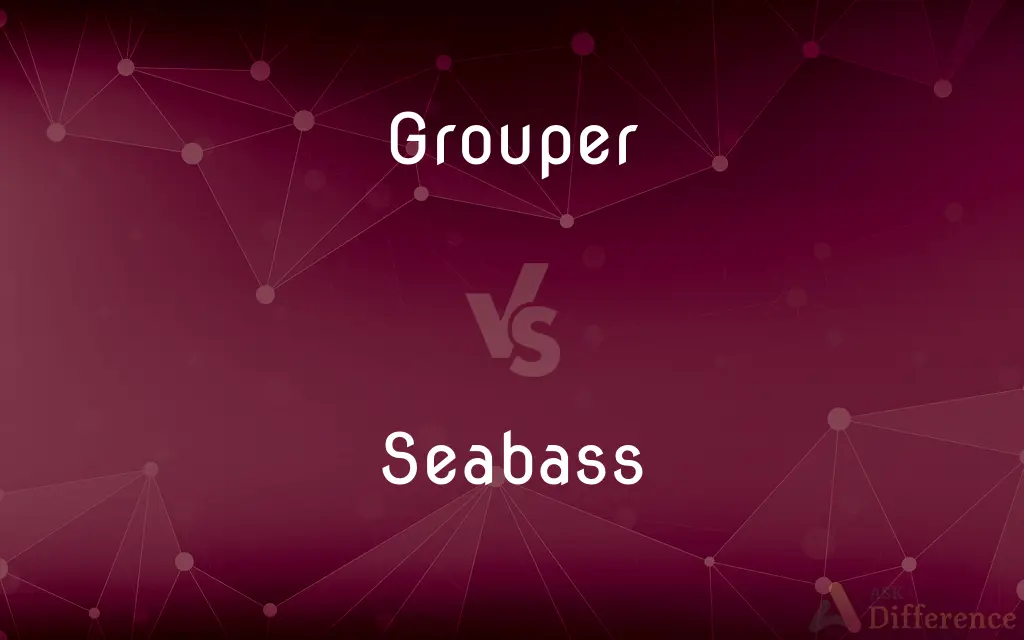Grouper vs. Seabass — What's the Difference?
By Tayyaba Rehman & Urooj Arif — Updated on April 26, 2024
Groupers are robust, bottom-dwelling fish known for their stout bodies and wide mouths, while seabass are more streamlined, thriving in varied marine habitats.

Difference Between Grouper and Seabass
Table of Contents
ADVERTISEMENT
Key Differences
Groupers are typically larger and have a stockier build, which aids in their ambush predation techniques, whereas seabass, being more slender and agile, are adapted for active chasing of prey.
Groupers often inhabit reef areas or rocky bottoms, relying on their environment for camouflage; on the other hand, seabass can be found in a wide range of environments, from open oceans to estuaries, showing greater ecological versatility.
The diet of a grouper mainly consists of crustaceans and smaller fish, captured through sudden bursts from hiding spots. Seabass, however, often hunt in open water and have a diet that includes a wider variety of fish and invertebrates.
Groupers are solitary creatures, interacting mainly during spawning seasons, while seabass are more often found in schools, especially in younger stages, which provides safety in numbers.
In terms of fishing and culinary use, groupers are highly valued for their meaty texture and are often sold as fillets or steaks, whereas seabass are prized for their milder flavor and are commonly served whole in various culinary traditions.
ADVERTISEMENT
Comparison Chart
Body Shape
Stout and wide
Streamlined and elongated
Habitat
Reefs and rocky bottoms
Varied, including oceans and estuaries
Hunting Technique
Ambush from hiding spots
Active chasing in open water
Social Behavior
Solitary except during spawning
Often found in schools
Culinary Use
Sold as fillets or steaks
Commonly served whole
Compare with Definitions
Grouper
Often features in luxury seafood dishes.
The restaurant's menu highlights a grilled grouper with herbs.
Seabass
Valued for its delicate flavor in culinary circles.
She prepared a light seabass fillet for dinner.
Grouper
Can live for many years, growing very large.
The oldest grouper in the aquarium is over 30 years old.
Seabass
Adaptable to both marine and brackish environments.
Seabass thrive in the estuary's mixed waters.
Grouper
A large, robust fish known for its ability to swallow prey whole.
The grouper hid among the rocks, waiting to engulf its unsuspecting prey.
Seabass
Commonly targeted by both commercial and sport fisheries.
They planned a seabass fishing expedition next weekend.
Grouper
Found primarily in tropical and subtropical waters.
Divers spotted several groupers near the coral reef.
Seabass
Known for its schooling behavior during its juvenile stage.
Young seabass typically form schools for protection.
Grouper
Groupers are fish of any of a number of genera in the subfamily Epinephelinae of the family Serranidae, in the order Perciformes. Not all serranids are called "groupers"; the family also includes the sea basses.
Seabass
A sleek, fast-swimming fish often found in temperate seas.
The seabass darted through the water after small fish.
Grouper
Popular in recreational fishing due to its size and challenge.
He caught a massive grouper on his latest fishing trip.
Seabass
Alternative form of sea bass, used especially in compound terms.
Grouper
Any of various often large serranid fishes of the subfamily Epinephelinae, found in tropical and subtropical waters worldwide and valued as food and game fish.
Grouper
Any of various large food and game fishes of the subfamily Epinephelinae, especially the genera Epinephelus and Mycteroperca, which inhabit warm seas.
Grouper
One who groups things.
Grouper
(dated) groupie
Grouper
One of several species of valuable food fishes of the genus Epinephelus, of the family Serranidæ, as the red grouper, or brown snapper (Epinephelus morio), and the black grouper, or warsaw (Epinephelus nigritus), both from Florida and the Gulf of Mexico.
Grouper
Flesh of a saltwater fish similar to sea bass
Grouper
Usually solitary bottom sea basses of warm seas
Common Curiosities
How do the reproductive behaviors of groupers differ from those of seabass?
Groupers often gather in large numbers for spawning, creating spawning aggregations, while seabass spawn in more dispersed patterns.
What makes grouper a preferred fish for aquariums compared to seabass?
Groupers' larger size and more dramatic appearance make them popular in large public and private aquariums.
What is the typical size range of groupers compared to seabass?
Groupers can grow significantly larger than seabass, with some species weighing over 100 kilograms.
Are groupers or seabass more expensive on the market?
Generally, grouper tends to be more expensive due to its larger size and the demand for its meat in luxury seafood markets.
Can both groupers and seabass be found in shallow waters?
Yes, both can be found in shallow waters, but groupers are more likely to dwell near the seabed.
What are the conservation statuses of groupers and seabass?
Many grouper species are considered at risk due to overfishing, whereas seabass populations are generally more stable but still face pressure from fishing.
What types of groupers and seabass are most commonly eaten?
Commonly eaten groupers include the Goliath and Red grouper, while European seabass and Black seabass are popular culinary choices.
How do the lifespans of groupers and seabass compare?
Groupers typically have longer lifespans, some living up to 30 years or more, while seabass often have shorter lifespans.
What fishing techniques are commonly used to catch grouper and seabass?
Grouper fishing often involves deep-sea bottom fishing techniques, while seabass may be caught using a variety of methods, including line fishing and netting.
Do groupers and seabass have different dietary preferences?
Yes, groupers often eat crustaceans and smaller fish, relying on ambush tactics, whereas seabass have a more varied diet that includes fish, squid, and crustaceans.
How do the textures of grouper and seabass meat compare?
Grouper meat is firm and moist with large flakes, making it suitable for steaks and fillets, while seabass is finer-textured and more delicate, ideal for whole fish recipes.
Which is more sustainable to eat, grouper or seabass?
Seabass is often considered more sustainable than grouper, especially when farmed in environmentally responsible systems.
Share Your Discovery

Previous Comparison
John vs. Edward
Next Comparison
Jamoke vs. JabroniAuthor Spotlight
Written by
Tayyaba RehmanTayyaba Rehman is a distinguished writer, currently serving as a primary contributor to askdifference.com. As a researcher in semantics and etymology, Tayyaba's passion for the complexity of languages and their distinctions has found a perfect home on the platform. Tayyaba delves into the intricacies of language, distinguishing between commonly confused words and phrases, thereby providing clarity for readers worldwide.
Co-written by
Urooj ArifUrooj is a skilled content writer at Ask Difference, known for her exceptional ability to simplify complex topics into engaging and informative content. With a passion for research and a flair for clear, concise writing, she consistently delivers articles that resonate with our diverse audience.














































